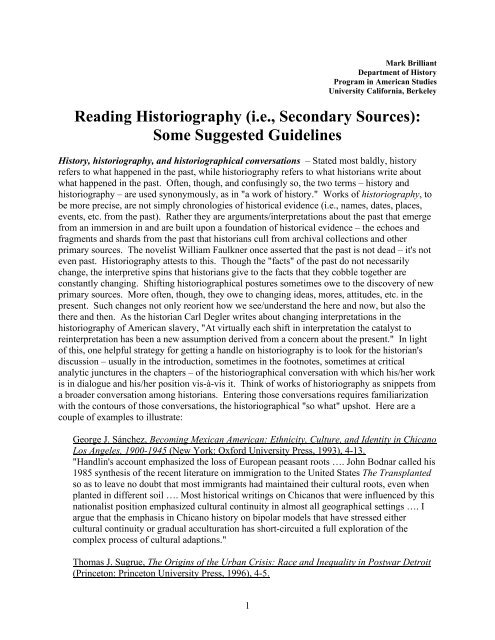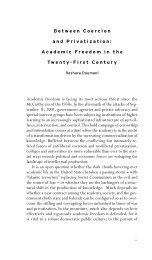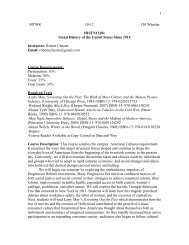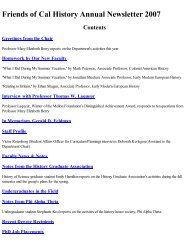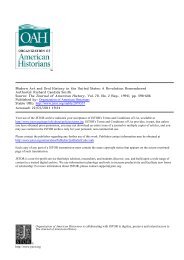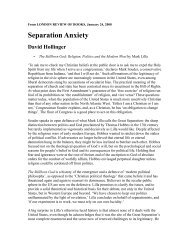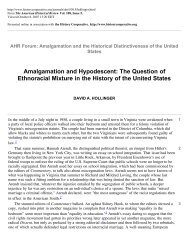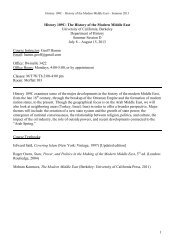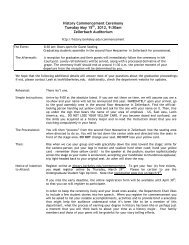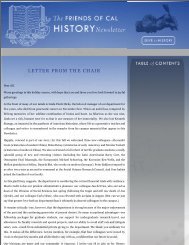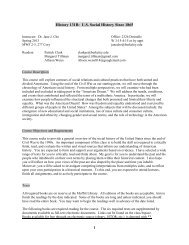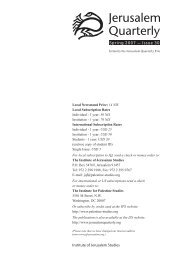Reading Historiography - Department of History, UC Berkeley
Reading Historiography - Department of History, UC Berkeley
Reading Historiography - Department of History, UC Berkeley
Create successful ePaper yourself
Turn your PDF publications into a flip-book with our unique Google optimized e-Paper software.
Mark Brilliant<br />
<strong>Department</strong> <strong>of</strong> <strong>History</strong><br />
Program in American Studies<br />
University California, <strong>Berkeley</strong><br />
<strong>Reading</strong> <strong>Historiography</strong> (i.e., Secondary Sources):<br />
Some Suggested Guidelines<br />
<strong>History</strong>, historiography, and historiographical conversations – Stated most baldly, history<br />
refers to what happened in the past, while historiography refers to what historians write about<br />
what happened in the past. Often, though, and confusingly so, the two terms – history and<br />
historiography – are used synonymously, as in "a work <strong>of</strong> history." Works <strong>of</strong> historiography, to<br />
be more precise, are not simply chronologies <strong>of</strong> historical evidence (i.e., names, dates, places,<br />
events, etc. from the past). Rather they are arguments/interpretations about the past that emerge<br />
from an immersion in and are built upon a foundation <strong>of</strong> historical evidence – the echoes and<br />
fragments and shards from the past that historians cull from archival collections and other<br />
primary sources. The novelist William Faulkner once asserted that the past is not dead – it's not<br />
even past. <strong>Historiography</strong> attests to this. Though the "facts" <strong>of</strong> the past do not necessarily<br />
change, the interpretive spins that historians give to the facts that they cobble together are<br />
constantly changing. Shifting historiographical postures sometimes owe to the discovery <strong>of</strong> new<br />
primary sources. More <strong>of</strong>ten, though, they owe to changing ideas, mores, attitudes, etc. in the<br />
present. Such changes not only reorient how we see/understand the here and now, but also the<br />
there and then. As the historian Carl Degler writes about changing interpretations in the<br />
historiography <strong>of</strong> American slavery, "At virtually each shift in interpretation the catalyst to<br />
reinterpretation has been a new assumption derived from a concern about the present." In light<br />
<strong>of</strong> this, one helpful strategy for getting a handle on historiography is to look for the historian's<br />
discussion – usually in the introduction, sometimes in the footnotes, sometimes at critical<br />
analytic junctures in the chapters – <strong>of</strong> the historiographical conversation with which his/her work<br />
is in dialogue and his/her position vis-à-vis it. Think <strong>of</strong> works <strong>of</strong> historiography as snippets from<br />
a broader conversation among historians. Entering those conversations requires familiarization<br />
with the contours <strong>of</strong> those conversations, the historiographical "so what" upshot. Here are a<br />
couple <strong>of</strong> examples to illustrate:<br />
George J. Sánchez, Becoming Mexican American: Ethnicity, Culture, and Identity in Chicano<br />
Los Angeles, 1900-1945 (New York: Oxford University Press, 1993), 4-13.<br />
"Handlin's account emphasized the loss <strong>of</strong> European peasant roots …. John Bodnar called his<br />
1985 synthesis <strong>of</strong> the recent literature on immigration to the United States The Transplanted<br />
so as to leave no doubt that most immigrants had maintained their cultural roots, even when<br />
planted in different soil …. Most historical writings on Chicanos that were influenced by this<br />
nationalist position emphasized cultural continuity in almost all geographical settings …. I<br />
argue that the emphasis in Chicano history on bipolar models that have stressed either<br />
cultural continuity or gradual acculturation has short-circuited a full exploration <strong>of</strong> the<br />
complex process <strong>of</strong> cultural adaptions."<br />
Thomas J. Sugrue, The Origins <strong>of</strong> the Urban Crisis: Race and Inequality in Postwar Detroit<br />
(Princeton: Princeton University Press, 1996), 4-5.<br />
1
"The 'underclass' debate has moved in three – sometimes overlapping – directions. The first,<br />
and most influential, focuses on the behavior and values <strong>of</strong> the poor, and the role <strong>of</strong> federal<br />
social programs in fostering a culture <strong>of</strong> joblessness and dependency in inner cities …. The<br />
second <strong>of</strong>fers structural explanations for inequality and urban poverty …. A third explanation<br />
focuses on politics, emphasizing the marginalization <strong>of</strong> cities in American social policy,<br />
particularly in the aftermath <strong>of</strong> the urban unrest and racial conflict <strong>of</strong> the 1960s …. [W]hat is<br />
largely missing from the 'underclass' debate is the perspective <strong>of</strong> history. My examination <strong>of</strong><br />
Detroit in the quarter-century after World War II suggests …"<br />
What is the question (or questions) to which the work <strong>of</strong> historiography <strong>of</strong>fers an answer?<br />
Historians arrive at their projects in a number <strong>of</strong> ways. Sometimes they identify (or stumble<br />
upon) a curious or anomalous set <strong>of</strong> circumstances or confluence <strong>of</strong> historical events. Other<br />
times, they are driven by more presentist concerns - a current issue or event whose historical<br />
lineage they'd like to trace. Still other times, perhaps most <strong>of</strong> the time, they simply have an issue<br />
or event from the past about which they'd like to know more. Starting points such as these, in<br />
turn, give rise to a research question or questions to which historians propose to <strong>of</strong>fer an answer<br />
(or, more accurately, an interpretation or argument). Sometimes historians make that question<br />
explicit to their readers, usually in the introduction. Sometimes it's only implicit. Identifying the<br />
question to which a work <strong>of</strong> historiography proposes to give an answer <strong>of</strong>ten provides an<br />
important leverage point for grappling with the onslaught <strong>of</strong> historical details that follow. Here is<br />
an example to illustrate:<br />
Ruth Feldstein, Motherhood in Black and White: Race and Sex in American Liberalism,<br />
1930-1965 (Ithaca: Cornell University Press, 2000), 1:<br />
When I ask students to describe the 1950s, they <strong>of</strong>fer two types <strong>of</strong> adjectives and images.<br />
Conservative, suburban, apathetic, they begin. Stay-at-home mothers in aprons, fathers<br />
coming home from work, teenage girls in poodle skirts at high school dances – these are<br />
some <strong>of</strong> the images that come to the minds <strong>of</strong> those reared on reruns <strong>of</strong> Happy Days and<br />
Leave It to Beaver. But many <strong>of</strong> these same students also associate this period with the early<br />
years <strong>of</strong> the civil rights movement: they use adjectives like rebellious, courageous, and<br />
dignified to describe Rosa Parks in Montgomery, Alabama, the "Little Rock Nine" in<br />
Arkansas, and other icons <strong>of</strong> grassroots activism.<br />
I began this book with similar associations. It was not clear to me what they had to do<br />
with each other. It was difficult to understand why, what Betty Friedan later called the<br />
"feminine mystique," flourished in the same era that the civil rights movement gained<br />
momentum. How was it that liberal ideas about race relations gained ascendance in the same<br />
period that conservative ideas about gender relations seemed so entrenched?<br />
What is the thesis? The thesis is the analytical heart and soul <strong>of</strong> any work <strong>of</strong> historiography.<br />
Thesis statements almost always appear somewhere in the introduction. They may vary in length<br />
from a few sentences to a few pages. They may be straightforward or multifaceted, comprised <strong>of</strong><br />
a number <strong>of</strong> different strands or sub-theses. Sometimes the historian cues you into the thesis<br />
with statements such as "I argue," or "I contend," etc. Other times the thesis is less explicitly<br />
presented. Whether explicit or implicit, the thesis is the interpretive posture assumed, argument<br />
to be made, position to be defended, etc., in its most pithy analytic articulation. If history is, as<br />
an old adage goes, philosophy reasoning by example, then the thesis statement <strong>of</strong> any historical<br />
2
work is the philosophy as yet embellished by example, the analysis as yet buttressed by<br />
evidence, the entire spool <strong>of</strong> interpretive thread that the historian will subsequently unravel.<br />
Identifying the thesis is absolutely essential for framing and understanding the chapters that<br />
follow. Here is an example <strong>of</strong> a thesis statement:<br />
Lizabeth Cohen, Making a New Deal: Industrial Workers in Chicago, 1919-1939 (New<br />
York: Cambridge University Press, 1990), 5-6:<br />
This book is devoted to explaining how it was possible and what it meant for industrial<br />
workers to become effective as national political participants in the mid-1930s, after having<br />
sustained defeats in 1919 and having refrained from unionism and national politics during the<br />
1920s. Why did workers suddenly succeed in the thirties as both CIO trade unionists and<br />
Democratic Party faithfuls? Certainly, changes in the larger political environment mattered;<br />
repressive measures like government's and employers' use <strong>of</strong> Red Scare tactics in 1919 and<br />
facilitating factors such as the Wagner Act <strong>of</strong> 1935 influenced whether workers' political<br />
efforts failed or flourished. But I will argue in this book that these external influences by no<br />
means tell the whole story, that their effectiveness in thwarting or encouraging workers'<br />
efforts depended as much on working people's own inclinations as on the strengths <strong>of</strong> their<br />
opponents or allies. This book will contend that what matters most in explaining why<br />
workers acted politically in the ways they did during the mid-thirties is the change in<br />
workers' own orientation during the 1920s and 1930s. Working-class Americans underwent<br />
a gradual shift in attitudes and behavior over the intervening decade and a half as a result <strong>of</strong> a<br />
wide range <strong>of</strong> social and cultural experiences. Daily life both inside and outside the<br />
workplace and factors as diverse as where workers turned for help in good times and bad,<br />
how they reacted to their employers' "welfare capitalist" schemes, and whether they were<br />
enticed by the new chain stores, motion picture palaces, and network radio shows or<br />
preferred the comfort <strong>of</strong> more familiar ethnic associations all are important in analyzing how<br />
workers' politics evolved. To understand why a bacon packer risked her job in the depths <strong>of</strong><br />
the depression by joining a union or why a Polish immigrant steelworker registered and voted<br />
for the first time in 1936 requires investigation into many facets <strong>of</strong> workers' lives during the<br />
1920s and the early depression that might not at first glance have seemed relevant.<br />
Chapters as building blocks – Think <strong>of</strong> individual chapters in a work <strong>of</strong> historiography as<br />
building blocks in the construction <strong>of</strong> the overarching thesis. As you descend into each chapter,<br />
try keeping one eye fixed on the chapter-level thesis and another eye fixed on how the chapterlevel<br />
thesis fits into and advances the overarching thesis. Doing so <strong>of</strong>ten requires you to return<br />
to the introduction as you read to reacquaint yourself with the big picture.<br />
Template for taking notes – Besides underlining and writing notes in the margins, you might<br />
consider a more systematic approach to note taking. For example, I try to distill each book or<br />
article I read into a couple pages worth <strong>of</strong> notes. To this end, I complete a template with the<br />
following categories: Central Question(s), Thesis/Themes, Chapter Summaries,<br />
Comments/Critique. These categories are by no means exhaustive, but they do at least <strong>of</strong>fer one<br />
way for thinking about how to break down a book or article.<br />
3


